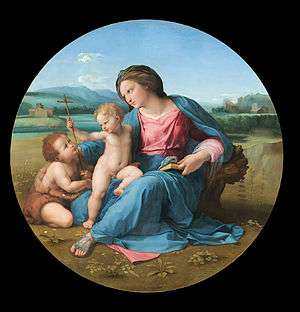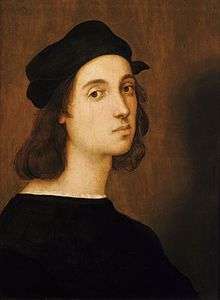Alba Madonna
 | |
| Artist | Raphael |
|---|---|
| Year | 1510 |
| Type | Oil transferred from wood to canvas |
| Dimensions | 94.5 cm diameter ( 37 1⁄4 in) |
| Location | National Gallery of Art, Washington, D.C. |
The Alba Madonna is a painting by the Italian High Renaissance artist Raphael, depicting Mary, Jesus and John the Baptist, in a typical Italian countryside. John the Baptist is holding up a cross to Jesus, which the baby Jesus is grasping. All three figures are staring at the cross. The three figures are grouped to the left in the round design, but the outstretched arm of the Madonna and the billowing material of her cloak balance the image.
This Madonna was commissioned by Paolo Giovio who planned to send it to the church of the Olivetani in Nocera dei Pagani. In the 18th century, the painting belonged to the Spanish House of Alba, whose name it bears. In 1836 it was acquired by Nicholas I of Russia, who made it one of the highlights of the Imperial Hermitage Museum in Saint Petersburg. A century later the Soviet Government clandestinely sold it to Andrew W. Mellon, who donated his collection to the National Gallery of Art in Washington, D.C., where it may be seen today.
During its time in the Hermitage, the painting would be transferred from a circular panel to a square canvas during the early nineteenth century. Through analysis of the painting, it was determined that the original panel was severely splitting down the center and on the right side. The canvas pattern is visible in the painting and the landscape on the far right was damaged in the transfer process.[1]

During World War II a group of over 100 pieces of art belonging to the National Gallery of Art, including this one, were transported by train to Asheville, NC where they would be stored in the unfinished music room of the Biltmore House. Done with the utmost secrecy, heavy steel doors were installed and bars were put in the windows of the barren music room. In 1944 after it became clear that the war would soon be over the paintings were moved back to the National Gallery of Art.
Art historian Andrew Graham-Dixon says of the painting:
The Alba Madonna is a breathtakingly beautiful work of art, all the more impressive since recent restoration work brought back the original, delicate pastel colours used by the artist, and revealed the subtle depth and brilliancy of the landscape background. The buildings on the hilltop at the right-hand edge of the composition are caught by a raking light and have been misted by varying degrees of haze to create the illusion of relative distance from the eye – a technique known as aerial perspective. The far mountains are similarly hazed by distance to a rich azure, while the sky above varies in colour from Wedgewood blue, at its apex, to a cool milky-white on the horizon. This range of colours is repeated in the folds and shadows of the Madonna’s blue robes, which at once echo and animate the circular shape of the composition. A monumental, comforting figure, clothed in robes that look as if woven from a piece of fallen sky, she seems like a world unto herself. Although she sits on the ground, which links her iconographically to the tradition of the Madonna of Humility, her statuesque grandeur calls to mind earlier Renaissance images of the Madonna della Misericordia – images of the Virgin as Queen of Heaven and protectress of all humanity. The faintest trace of archaism survives, in Raphael's painting technique, in the almost imperceptibly delicate gold halo inscribed into the air above her head.[2]
See also
References
- ↑ Christensen, Carol. "Examination and Treatment of Paintings by Raphael at the National Gallery of Art." Studies in the History of Art 17 (1986): 47–54.
- ↑ Graham-Dixon, Andrew (19 December 2004). "ITP 242: The Alba Madonna, by Raphael". Sunday Telegraph.
